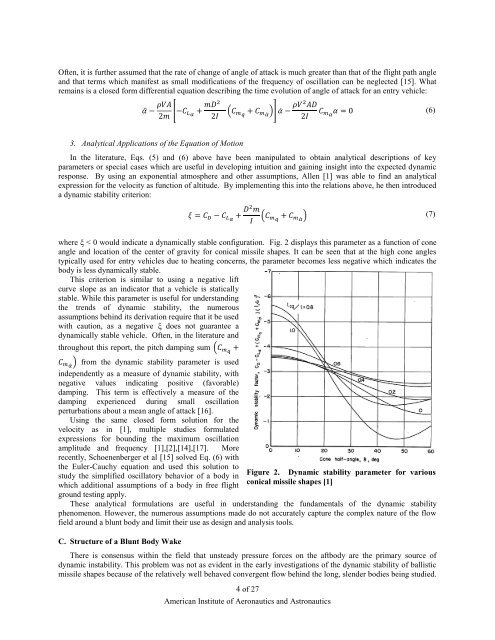Survey of Blunt Body Dynamic Stability in Supersonic Flow
Survey of Blunt Body Dynamic Stability in Supersonic Flow
Survey of Blunt Body Dynamic Stability in Supersonic Flow
You also want an ePaper? Increase the reach of your titles
YUMPU automatically turns print PDFs into web optimized ePapers that Google loves.
Often, it is further assumed that the rate <strong>of</strong> change <strong>of</strong> angle <strong>of</strong> attack is much greater than that <strong>of</strong> the flight path angle<br />
and that terms which manifest as small modifications <strong>of</strong> the frequency <strong>of</strong> oscillation can be neglected [15]. What<br />
rema<strong>in</strong>s is a closed form differential equation describ<strong>in</strong>g the time evolution <strong>of</strong> angle <strong>of</strong> attack for an entry vehicle:<br />
̈ [ (<br />
̇<br />
)] ̇ (6)<br />
3. Analytical Applications <strong>of</strong> the Equation <strong>of</strong> Motion<br />
In the literature, Eqs. (5) and (6) above have been manipulated to obta<strong>in</strong> analytical descriptions <strong>of</strong> key<br />
parameters or special cases which are useful <strong>in</strong> develop<strong>in</strong>g <strong>in</strong>tuition and ga<strong>in</strong><strong>in</strong>g <strong>in</strong>sight <strong>in</strong>to the expected dynamic<br />
response. By us<strong>in</strong>g an exponential atmosphere and other assumptions, Allen [1] was able to f<strong>in</strong>d an analytical<br />
expression for the velocity as function <strong>of</strong> altitude. By implement<strong>in</strong>g this <strong>in</strong>to the relations above, he then <strong>in</strong>troduced<br />
a dynamic stability criterion:<br />
(<br />
̇<br />
) (7)<br />
where ξ < 0 would <strong>in</strong>dicate a dynamically stable configuration. Fig. 2 displays this parameter as a function <strong>of</strong> cone<br />
angle and location <strong>of</strong> the center <strong>of</strong> gravity for conical missile shapes. It can be seen that at the high cone angles<br />
typically used for entry vehicles due to heat<strong>in</strong>g concerns, the parameter becomes less negative which <strong>in</strong>dicates the<br />
body is less dynamically stable.<br />
This criterion is similar to us<strong>in</strong>g a negative lift<br />
curve slope as an <strong>in</strong>dicator that a vehicle is statically<br />
stable. While this parameter is useful for understand<strong>in</strong>g<br />
the trends <strong>of</strong> dynamic stability, the numerous<br />
assumptions beh<strong>in</strong>d its derivation require that it be used<br />
with caution, as a negative ξ does not guarantee a<br />
dynamically stable vehicle. Often, <strong>in</strong> the literature and<br />
throughout this report, the pitch damp<strong>in</strong>g sum (<br />
) from the dynamic stability parameter is used<br />
̇<br />
<strong>in</strong>dependently as a measure <strong>of</strong> dynamic stability, with<br />
negative values <strong>in</strong>dicat<strong>in</strong>g positive (favorable)<br />
damp<strong>in</strong>g. This term is effectively a measure <strong>of</strong> the<br />
damp<strong>in</strong>g experienced dur<strong>in</strong>g small oscillation<br />
perturbations about a mean angle <strong>of</strong> attack [16].<br />
Us<strong>in</strong>g the same closed form solution for the<br />
velocity as <strong>in</strong> [1], multiple studies formulated<br />
expressions for bound<strong>in</strong>g the maximum oscillation<br />
amplitude and frequency [1],[2],[14],[17]. More<br />
recently, Schoenenberger et al [15] solved Eq. (6) with<br />
the Euler-Cauchy equation and used this solution to<br />
study the simplified oscillatory behavior <strong>of</strong> a body <strong>in</strong><br />
which additional assumptions <strong>of</strong> a body <strong>in</strong> free flight<br />
ground test<strong>in</strong>g apply.<br />
These analytical formulations are useful <strong>in</strong> understand<strong>in</strong>g the fundamentals <strong>of</strong> the dynamic stability<br />
phenomenon. However, the numerous assumptions made do not accurately capture the complex nature <strong>of</strong> the flow<br />
field around a blunt body and limit their use as design and analysis tools.<br />
C. Structure <strong>of</strong> a <strong>Blunt</strong> <strong>Body</strong> Wake<br />
Figure 2. <strong>Dynamic</strong> stability parameter for various<br />
conical missile shapes [1]<br />
There is consensus with<strong>in</strong> the field that unsteady pressure forces on the aftbody are the primary source <strong>of</strong><br />
dynamic <strong>in</strong>stability. This problem was not as evident <strong>in</strong> the early <strong>in</strong>vestigations <strong>of</strong> the dynamic stability <strong>of</strong> ballistic<br />
missile shapes because <strong>of</strong> the relatively well behaved convergent flow beh<strong>in</strong>d the long, slender bodies be<strong>in</strong>g studied.<br />
4 <strong>of</strong> 27<br />
American Institute <strong>of</strong> Aeronautics and Astronautics
















